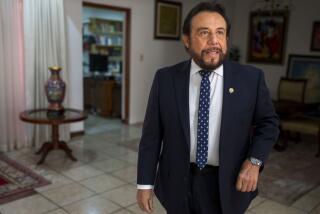Notorious Salvadoran Battalion Is Disbanded : Military: U.S.-trained Atlacatl unit was famed for battle prowess but was also implicated in atrocities.
SITIO DEL NINO, El Salvador — President Alfredo Cristiani on Tuesday disbanded the largest and oldest of El Salvador’s elite U.S.-trained counterinsurgency battalions, a unit that came to symbolize both the most aggressive in fighting and the worst in atrocities.
With air force bombers streaking the sky, the Atlacatl Battalion was dissolved in a somber military ceremony as part of United Nations-mediated peace accords that ended 12 years of civil war.
“You served a transcendental mission in the armed conflict,” Cristiani told about 600 Atlacatl infantrymen who stood at rigid attention in a soccer field at the Atlacatl headquarters 20 miles northeast of the capital. “You fought with mysticism, discipline, courage and valor. . . . You will always be remembered in the hearts of the Salvadoran people as heroes.”
The soldiers, wearing trademark red berets, put down their M-16 rifles as green, red and yellow smoke from army signaling devices filled the air. The unit’s black flag, bearing a skull and serpent, fluttered in the breeze.
The Atlacatl Battalion, formed in 1981 as El Salvador’s first rapid-response unit dedicated to fighting leftist guerrillas, was intended as an example of how American money and training could transform the Salvadoran army into a professional fighting force. With many of its officers trained at Ft. Bragg, N.C., the battalion specialized in counterinsurgency tactics.
Lightly armed, small units were transported to combat hot spots in helicopters, enabling soldiers to respond more quickly to fast-moving guerrilla bands.
At the same time, the battalion became enmeshed in some of the most egregious abuses of El Salvador’s civil war. An Atlacatl platoon killed six Jesuit priests in 1989 at the height of a guerrilla offensive, and the Roman Catholic Church and human rights groups have implicated Atlacatl members in the 1981 massacre of hundreds of peasants and their children near a remote hamlet known as El Mozote. A number of other mass killings have also been blamed on the battalion.
Cristiani, speaking to reporters after the ceremony, said such incidents were “individual acts of people . . . not the battalion as an institution.”
Near the ceremony, about 200 supporters of the leftist Farabundo Marti National Liberation Front protested in front of the Atlacatl compound. They bore black crosses with the words “El Mozote” and a black coffin labeled “Atlacatl.” A huge banner said, “Demobilize Now! The People Repudiate You!”
U.N. peacekeepers formed a cordon between the demonstrators and Salvadoran riot police. No arrests were reported, although one protester struggled with a U.N. official over spray paint he was using to draw skeletons on the battalion’s driveway.
The Atlacatl is the third of five counterinsurgency battalions being dismantled under the peace accords. Its dissolution came after U.N. Secretary General Boutros Boutros-Ghali certified that a guerrilla inventory of weapons, turned in last week, was “satisfactory.”
The accords also call for other reforms in the military, including a purge of corrupt officers and human rights abusers and a reduction in the size of the army. Cristiani reiterated Tuesday his intention to continue fulfilling the accords, saying the military cutbacks are the “logical consequence of the end of the war.” The guerrillas, in turn, must disarm by next Tuesday, the anticipated formal end of the war.
A military spokesman said the Atlacatl Battalion was made up of about 1,100 men. Many will simply transfer to other army brigades, while some will return to civilian life.
“Well, it’s a little sad,” infantryman Victor Hernandez, 26, said shortly before relinquishing his weapon after serving eight years in the unit. “But I feel satisfied for having served the country and having been part of the Atlacatl.” Like many, he plans to take classes to train him for a new job.
A huge portrait of Col. Jose Domingo Monterrosa, the first commander of battalion, hung above the soccer field. Monterrosa, who died when guerrillas blew up his helicopter in 1984, is regarded by the military as one of the war’s greatest heroes. Praised by Cristiani on Tuesday as the embodiment of “courage, patriotism and sacrifice,” Monterrosa is said to have been one of the directors of the Mozote massacre.
He was also implicated two years later, in 1983, in the slaying of about 100 peasants at a village called Copapayo. Journalists who reached survivors were told that Monterrosa identified himself to villagers, admonishing them not to forget his face because he was going to kill “all of you Communists.”
More to Read
Sign up for Essential California
The most important California stories and recommendations in your inbox every morning.
You may occasionally receive promotional content from the Los Angeles Times.











